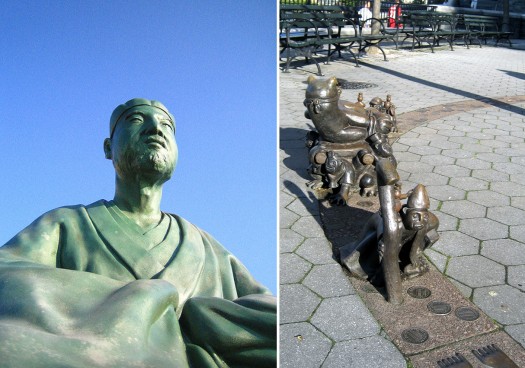
We are celebrating 15 years — and counting — of stories that are deeply researched and deeply felt, that build a historical record of what the city has been.
We are celebrating 15 years — and counting — of stories that are deeply researched and deeply felt, that build a historical record of what the city has been.
A trip to the riverfront presents a welcome opportunity to shave a few degrees off a sweltering afternoon, so last weekend I joined a group following poet Jon Cotner through Rockefeller Park in Battery Park City. The walk and discussion was the first installment of We’re Floating, an “interactive poetry walk” inspired by the work of 17th century Japanese poet Matsuo Basho, organized by Poets House as part of the River to River Festival. Cotner will lead a second group of the 45-minute walks this Saturday, July 14th starting every hour from 4:00 to 7:00 pm.

Left: a sculpture of Matsuo Basho in Tokyo | Right: figures from Tom Otterness’ The Real World in Nelson Rockefeller Park
Last year, Cotner shared with Urban Omnibus readers his interest in reviving “the ancient, endangered practices of walking and talking.” “Whenever you walk,” he continues, “you might be considering something from your afternoon or thinking about something you’ve read. Then, all of a sudden, something else arises: somebody walks by with a dog, somebody pushes a carriage, you name it, and you are pulled out of yourself and confronted with what might be called the external world.”
We’re Floating provides that “something else” in the form of engagement with a group of strangers and an unfamiliar body of artwork, as well as the opportunity to visit a part of the city that I – and many other New Yorkers – rarely have had occasion to explore. Battery Park City is unique in New York, and being immersed in it while simultaneously being exposed to Bosho’s work for the first time revealed more about the place and the poet than exploring either one on its own would have done. While the words and thoughts of Basho are stirring and deep, what I left remembering wasn’t so much his work as what it caused me to reflect upon walking through the park, the condos, observing the long shadows of towering financial institutions and the open view across the Hudson. Talking about poetry and grand universal ideas opens and unsettles you enough to experience this unique part of Manhattan with a fresh and open set of eyes. We also learned a few facts about Basho’s life and his particular kind of immersion: he lived much of it in a hut of banana leaves built for him by some of his disciples, exposed to freezing cold. A type of immersion more typical of contemporary New York is our regular practice of living only within the confines of our own communities, work environments or social networks. We’re Floating offers an alternative; the result might not be floatation so much as a different kind of immersion, walking around unfamiliar surroundings with people you don’t know.
Battery Park City provides an oddly fitting context for this kind of re-engagement with the unfamiliar. Built mostly on construction fill from the original World Trade Center, the neighborhood feels palpably separate from Lower Manhattan, partly because of the eight lanes of West Side Highway traffic that define its eastern border. The neighborhood, which was recently awarded the Urban Land Institute’s Heritage Award, stands as an important marker in planning history. The building types are varied, but they haven’t given birth to a lively streetscape. Each stage of the development feels separate from the others, preventing a strong neighborhood character. But Rockefeller Park succeeds in feeling like a neighborhood park, complete with its own society of floating creatures in the park’s playground: the lovable cartoonish characters sculpted by Tom Otterness, frozen in narrative tableaux (cousins of the bronze inhabitants of the 14th Street / 8th Avenue subway station).
We’re Floating provides not only a good excuse to check out this unique part of New York, but also equips its participants with new strategies of immersion and observation. As such, it fits with a trend of creative urban exploration that is hopefully growing. The walking tour, as an event format, is more often associated with history and legend than poetic imagination and genuine exploration. Cotner’s walk resonates with other walks-as-artwork, including the offerings of Elastic City, some of the events organized as part of StillspottingNYC, and many others. Urban Omnibus has covered both projects (see here and here) in the past, and will continue to follow how artists and designers create experiences that fuse exploration and reflection in the built environment of New York. Stay tuned.
Nelson Rockefeller Park
Nelson Rockefeller Park photos by flickr user WallyG. Basho sculpture photo by flickr user Ayustety.The views expressed here are those of the author only and do not reflect the position of Urban Omnibus editorial staff or the Architectural League of New York.
The views expressed here are those of the authors only and do not reflect the position of The Architectural League of New York.
Comments